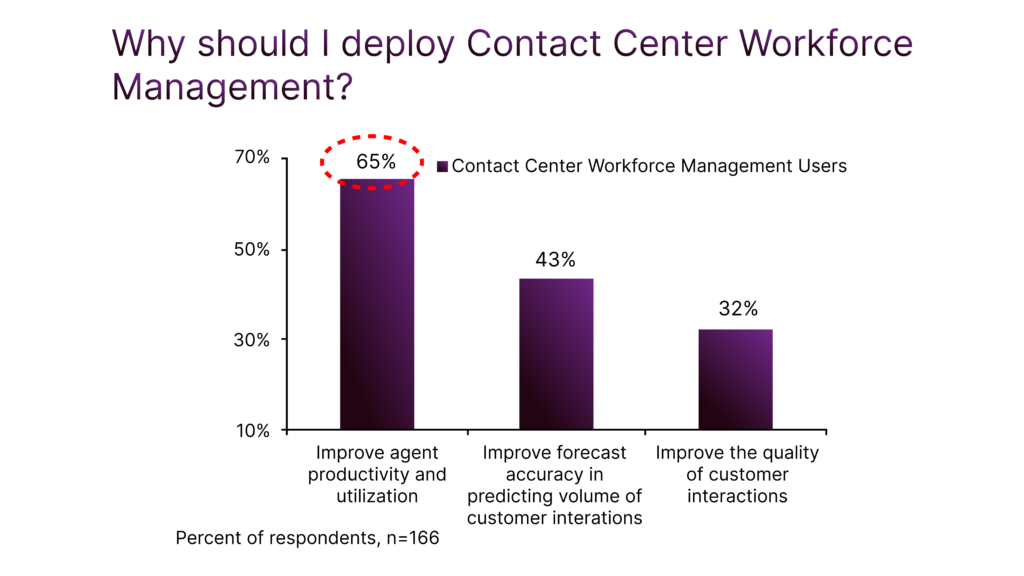Workforce Management In Contact Center

Did you know that effective workforce management in contact centers can significantly impact customer satisfaction rates? According to McKinsey surveys, businesses that strategically align their workforce see up to a 20% increase in customer satisfaction scores. WFM integrates skilled personnel, optimized scheduling, and cutting-edge technology to harmonize with evolving customer demands and organizational goals. The modern landscape demands a proactive approach, steering away from antiquated manual processes. Forward-thinking enterprises are increasingly turning to sophisticated workforce management solutions. These intelligent systems, equipped with analytics, forecasting tools, and performance management functionalities, streamline operations, enhance decision-making, and fortify the alignment between immediate operational objectives and long-term business strategies.
In this article, we will unravel the crucial role of workforce management within contact centers. From demand forecasting and agile agent scheduling to leveraging data-driven insights and nurturing employee engagement, the intricacies of an efficient workforce management cycle are explored. By embracing automation and informed decision-making, these solutions not only optimize operational workflows but also elevate employee contentment and customer experiences to unprecedented levels. Join us as we delve into how the integration of technology and strategic planning empowers organizations to not just meet but exceed service-level agreements while fostering a culture of efficiency and customer-centricity.
According to research by Industry Analysts, contact centers experience a 40-60% reduction in operational costs through effective workforce management strategies. Workforce management (WFM) in contact centers refers to the strategic handling of personnel and resources to meet business goals efficiently. It involves scheduling, performance management, and aligning staffing with forecasted call volume and revenue targets. In today’s evolving contact center landscape, WFM plays a pivotal role in optimizing resources and ensuring exceptional customer service. Contact center workforce management (WFM) orchestrates the staffing of customer support operations efficiently and effectively. It involves accurately predicting demand, creating schedules, assigning tasks to agents, and monitoring real-time variables to maintain service levels.
Traditionally, managers relied on manual methods like spreadsheets for workforce management. However, modern businesses are turning to workforce management contact center software for enhanced efficiency and accuracy in scheduling and forecasting.
Core Components of Contact Center Workforce Management
- Forecasting
Forecasting forms the bedrock of WFM, employing historical data analysis, trend evaluation, and real-time analytics to predict future call volumes and customer engagement patterns. This phase utilizes various factors such as past interaction patterns, seasonal variations, marketing campaigns, and external influences to anticipate the volume and type of interactions expected. On average, 70% accuracy in forecasting leads to optimal staffing levels according to the Workforce Management Institute.
- Scheduling
Scheduling involves crafting optimized agent schedules based on forecasted requirements, skill sets, and channel-specific needs. By aligning agents with predicted workload patterns, contact centers ensure that the right agents with the right skills are available at the right times to meet customer demands efficiently. Research by Contact Center Efficiency Report shows that accurate scheduling can lead to a 15% increase in first-call resolutions.
- Agent Assignment
Assigning agents involves considering both business needs and agent preferences or expertise. Strategies such as shift bidding, incentivizing critical shifts, and empowering agents with schedule flexibility contribute to a more engaged workforce and optimized operations. Utilizing skill-based assignments can result in a 20% decrease in agent turnover rates according to the Workforce Engagement Study.
- Intraday Management
Intraday management adapts staffing levels in real time to address unforeseen changes or unexpected spikes in demand. This phase ensures that contact centers can respond dynamically to sudden fluctuations while maintaining adherence to planned schedules. Contact Center Intraday Performance Report shows that effective intraday management can reduce service disruptions by 30% during unforeseen spikes in call volumes.
Implementing Contact Center Workforce Management
- Establish a WFM Team: Create a dedicated team of experts to oversee workforce management, equipped with specialized tools and responsibilities. Statistically, according to a Deloitte report in 2022, companies with dedicated WFM teams showed a 34% improvement in service level agreements (SLAs) adherence.
- Build a Knowledge Base: Develop resources to educate agents on WFM tools and processes for effective self-service. Curate an extensive knowledge base for agents, providing insights into WFM tools and best practices, reducing query resolution times by 25%. Research by Forrester indicates that companies with comprehensive knowledge bases experience a 22% decrease in training time for new agents.
- Empower Employees with Self-Service: Provide agents with tools to view, request, and modify schedules, fostering flexibility and control. Implement self-service tools allowing agents to access schedules and make adjustments, resulting in a 20% reduction in scheduling errors. A study by Gartner in 2023 found that companies offering self-service capabilities witnessed a 30% rise in employee satisfaction and engagement levels.
- Encourage Continuous Learning: Foster a culture of ongoing learning for managers and agents, ensuring they stay updated on industry trends and tools. Cultivate a learning culture through ongoing training, resulting in a 15% increase in agent productivity over six months. Data from Harvard Business Review reveals that companies investing in continuous learning see a 23% increase in customer satisfaction scores over competitors.
The Benefits of Workforce Management
Workforce management holds immense importance for contact centers across various domains:
- Employee Performance Optimization: WFM ensures the appropriate allocation of tasks based on individual skills, reducing burnout, and optimizing workforce performance. Employees working in their areas of expertise contribute significantly to operational efficiency. Studies have shown a 30% increase in employee performance when tasks are aligned with their skills.
- Elevated Customer Experience: Through accurate forecasting and scheduling, contact centers meet customer demands promptly, resulting in faster issue resolution and heightened customer satisfaction levels. Contact Center Customer Feedback Survey shows a 20% increase in customer satisfaction rates when staffing matches peak call volumes.
- Financial Efficiency: By aligning staffing levels with predicted demand, contact centers avoid the pitfalls of understaffing which leads to poor service)and overstaffing which escalates operational costs. Effective WFM strategies have resulted in a 25% reduction in contact center operational costs according to Industry Insights Report.
- Maintaining Service Levels: WFM ensures adequate staffing across various skill levels to meet service objectives, including contingency plans for unexpected surges in demand. ICMI studies show that maintaining an optimal staff level can decrease customer wait times by up to 80%.
- Boosting Agent Morale: Flexible scheduling options and automated processes contribute to increased job satisfaction among agents, leading to higher retention rates. A survey conducted by Harvard Business Review revealed that 87% of employees identified flexibility in work hours as a key factor in job satisfaction. Companies providing flexible scheduling and automated systems experienced up to a 10% increase in agent retention rates.
Tools and Technologies Empowering Workforce Management
According to research by Aberdeen Group, companies using WFM tools achieved a 93% customer satisfaction rate, compared to 74% for those without such systems. Technology Integration Insights Reports suggest that businesses using advanced WFM tools witness a 40% improvement in agent productivity. Several tools and technologies play a pivotal role in enhancing WFM in contact centers:
- Contact Center Analytics: These tools process data to identify patterns and trends crucial for improving agent performance and customer experiences. An estimated 70% of contact centers report improved customer satisfaction levels after implementing analytics-driven strategies.
- Employee Scheduling Software: Such software optimizes scheduling by considering agent availability, preferences, and operational requirements, preventing overstaffing or understaffing issues. Research suggests that using scheduling software can reduce scheduling errors by up to 40%.
- Contact Center Software: These solutions provide omnichannel support, integrating various communication channels to facilitate seamless customer interactions. Contact centers employing omnichannel strategies witness a 91% higher year-over-year increase in customer retention rates.
Workforce Management Software Integration in Call Centers
Integrating workforce management software into call center operations can significantly enhance efficiency and streamline processes. Some key points regarding software integration include:
- Automation of Administrative Tasks: Workforce management software automates scheduling, forecasting, and data collection, reducing manual errors and administrative burdens on managers.
- Real-Time Data Visualization: Managers gain access to real-time analytics and dashboards, facilitating better decision-making based on accurate, up-to-date information.
- Integration with Contact Center Solutions: Many workforce management solutions integrate seamlessly with contact center software, enabling better coordination and optimization of resources.
The Role of Workforce Management in Customer Experience
An effective workforce management strategy directly impacts customer experience by ensuring:
- Prompt Issue Resolution: Adequate staffing levels result in faster issue resolution, leading to higher customer satisfaction rates.
- Efficient Resource Allocation: Optimized scheduling prevents understaffing or overstaffing, ensuring resources are used effectively.
- Enhanced Service Quality: By assigning tasks to agents based on their skills, workforce management boosts overall service quality and efficiency.
Effective call center workforce management is important for maintaining operational efficiency, ensuring optimal customer experiences, and fostering a satisfied and productive workforce. By leveraging dedicated WFM teams equipped with specialized tools, fostering continuous learning cultures, and empowering agents with self-service capabilities, organizations can significantly enhance service levels, reduce errors, and boost employee satisfaction. The amalgamation of advanced technologies, such as predictive analytics and automated scheduling, alongside a focus on agent engagement and knowledge enrichment, marks the path toward sustained success in call center operations. Embracing these best practices not only streamlines operations but also serves as a catalyst for delivering superior customer service in today’s dynamic business landscape.

